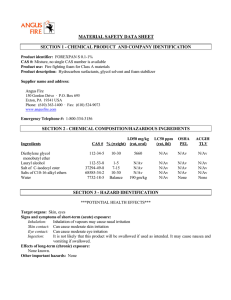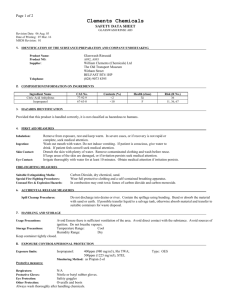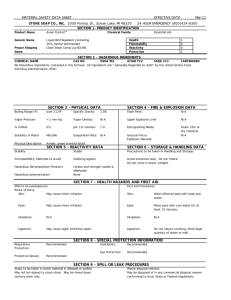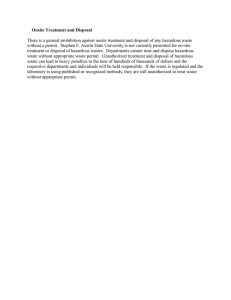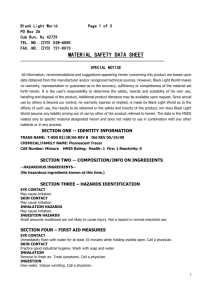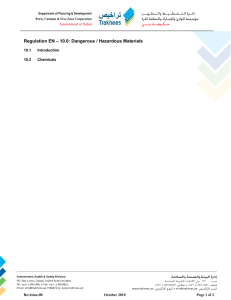MATERIAL SAFETY DATA SHEET
advertisement
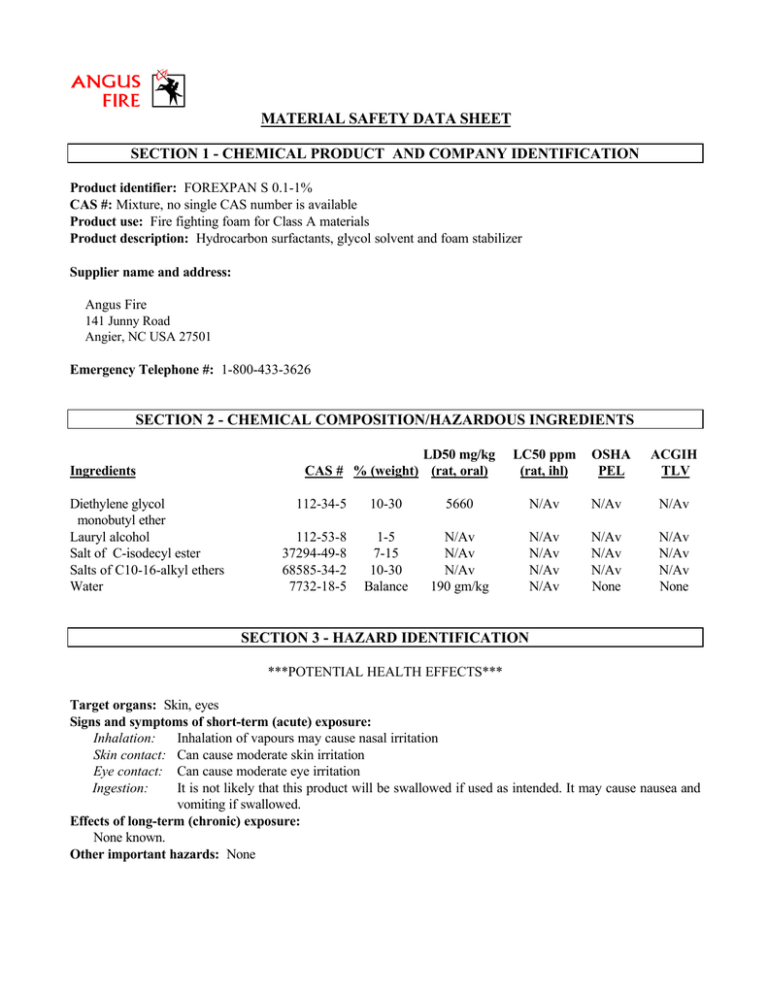
MATERIAL SAFETY DATA SHEET SECTION 1 - CHEMICAL PRODUCT AND COMPANY IDENTIFICATION Product identifier: FOREXPAN S 0.1-1% CAS #: Mixture, no single CAS number is available Product use: Fire fighting foam for Class A materials Product description: Hydrocarbon surfactants, glycol solvent and foam stabilizer Supplier name and address: Angus Fire 141 Junny Road Angier, NC USA 27501 Emergency Telephone #: 1-800-433-3626 SECTION 2 - CHEMICAL COMPOSITION/HAZARDOUS INGREDIENTS Ingredients Diethylene glycol monobutyl ether Lauryl alcohol Salt of C-isodecyl ester Salts of C10-16-alkyl ethers Water LD50 mg/kg CAS # % (weight) (rat, oral) 112-34-5 112-53-8 37294-49-8 68585-34-2 7732-18-5 LC50 ppm (rat, ihl) OSHA PEL ACGIH TLV 10-30 5660 N/Av N/Av N/Av 1-5 7-15 10-30 Balance N/Av N/Av N/Av 190 gm/kg N/Av N/Av N/Av N/Av N/Av N/Av N/Av None N/Av N/Av N/Av None SECTION 3 - HAZARD IDENTIFICATION ***POTENTIAL HEALTH EFFECTS*** Target organs: Skin, eyes Signs and symptoms of short-term (acute) exposure: Inhalation: Inhalation of vapours may cause nasal irritation Skin contact: Can cause moderate skin irritation Eye contact: Can cause moderate eye irritation Ingestion: It is not likely that this product will be swallowed if used as intended. It may cause nausea and vomiting if swallowed. Effects of long-term (chronic) exposure: None known. Other important hazards: None FOREXPAN 0.1 - 1% Page 2 of 5 SECTION 4 - FIRST AID MEASURES Inhalation: Skin contact: Eye contact: Ingestion: If someone feels ill after inhaling vapours, remove them to fresh air. Call a physician if symptoms do not go away quickly. If product gets on skin, wash off with large amounts of water If liquid is splashed in eyes, immediately flush eyes with lots of water for 15 minutes, including under the eyelids. Call a physician right away. If swallowed, call a physician or Poison Control Centre. DO NOT induce vomiting unless directed to do so by a physician. If vomiting does occur, position victim so that fluid does not drain back into lungs. SECTION 5 - FIRE FIGHTING MEASURES Fire hazards/conditions of flammability: Not flammable under normal conditions of use. Flash point (Method): >203°F (95°C) (Pensky Martens Closed Cup) Lower/Upper flammable limit (% by volume): Product is not flammable. Explosion data: Sensitivity to mechanical impact: Not sensitive to mechanical impact. Sensitivity to static discharge: Not sensitive to static discharge at temperatures below the flash point. Oxidizing properties: Product is not an oxidizer Auto-ignition temperature: N/Av Suitable extinguishing media: Not applicable. Special fire-fighting procedures/equipment: Not applicable. Hazardous combustion products: Not applicable. SECTION 6 - ACCIDENTAL RELEASE MEASURES Personal precautions: Environmental precautions: Spill response/Cleanup: Prohibited materials: Wear appropriate protective equipment (see Section 8). If in doubt about proper disposal, contact local, state or federal EPA (in USA) or municipal or provincial environmental authorities (in Canada). Wear appropriate protective equipment to collect spillage with an absorbent material. Flush area with water until foaming ceases, using caution as area may be slippery. Prevent discharge of concentrate into waterways. Obtain prior approval before discharge into sewer treatment systems. Disposal must be in accordance with federal, state or provincial, and local regulations. None. SECTION 7 - HANDLING AND STORAGE Safe handling procedures: Storage requirements: Incompatible materials: Special packaging materials: Product is for industrial and municipal fire department use only. Consult product literature for appropriate handling during fires. Store at 25°F - 120°F (-4°C - 49°C). As with all aqueous solutions, FOREXPAN should not be put in contact with any materials which react violently with water. Use original container or store in stainless steel, fibreglass or bitumen-lined tanks. FOREXPAN 0.1 - 1% Page 3 of 5 SECTION 8 - EXPOSURE CONTROLS AND PERSONAL PROTECTION Ventilation and engineering controls: Provide adequate levels of ventilation to prevent a build-up of vapours from the product. Respiratory protection: Not normally required under normal conditions of use. If vapours reach irritating levels, wear a NIOSH-approved respirator equipped with organic vapour cartridges. Protective gloves: Wear impervious gloves of an approved material, for example Neoprene. Eye protection: Wear safety glasses, chemical goggles or a face shield of an approved type. Other protective equipment: Body-covering clothing is recommended. Permissible exposure levels: None established for this product or its ingredients. Refer to Section 2, Hazardous Ingredients. SECTION 9 - PHYSICAL AND CHEMICAL PROPERTIES Physical form, color and odor: Clear pale yellow liquid, with a detergent odor. Odor threshold: Not available. pH @ 68°F (20°C): 7 Boiling point: 212°F (100°C) Melting/freezing point: 20°F (-7°C) Vapour pressure: Not available. Solubility in water: 100% Coefficient of oil/water distribution: Not available. Specific gravity (water = 1): 1.0 Vapour density: Not available Volatile organic compounds (VOC's): Less than 50% Evaporation rate: Not available SECTION 10 - REACTIVITY AND STABILITY DATA Stability and reactivity: Conditions to avoid: Materials to avoid: Hazardous decomposition products: Stable. Hazardous polymerization will not occur. None known. Contact with chemicals that react violently on contact with water, such as sodium metal. None known. SECTION 11 - TOXICOLOGICAL INFORMATION/HEALTH EFFECTS LD50: Greater than 5000 mg/kg (oral, rat); greater than 2020 mg/kg (dermal, rat). LC50: Not available Routes of exposure: Skin, eyes Carcinogenicity: No ingredient classed as carcinogenic by OSHA, IARC, ACGIH or NTP Teratogenicity, mutagenicity, other reproductive effects: None known. Sensitization to material: Product is not known to cause allergies. Conditions aggravated by exposure: None known. Synergistic materials: None known. FOREXPAN 0.1 - 1% Page 4 of 5 SECTION 12 - ECOLOGICAL INFORMATION Environmental effects: Product is expected to have a relatively low risk to the environment Important environmental characteristics: None known. Aquatic toxicity: LC50 (Rainbow trout [Ocorhynchus mykiss], 96 hours): 10.4 ppm. SECTION 13 - WASTE DISPOSAL Handling for disposal: Methods of disposal: Avoid contact with eyes and skin, and excessive inhalation. Do not ingest. Rinse skin and eyes thoroughly in case of contact. If in doubt about proper disposal, contact local, state or federal EPA (in USA) or municipal or provincial environmental authorities (in Canada). SECTION 14 - TRANSPORT INFORMATION Transportation of Dangerous Goods (TDG) information: Shipping description: Not regulated as dangerous goods according to TDG Regulations. 49 CFR information: Shipping description: Not regulated as hazardous material according to 49 CFR Hazardous Materials Regulations. International Dangerous Goods information: IMO: Not regulated as dangerous goods according to IMDG Code. ICAO: Not regulated as dangerous goods according to ICAO Technical Instructions or IATA Regulations. Other information: None. SECTION 15 - REGULATORY INFORMATION WHMIS information: This product has been classified in accordance with the hazard criteria of the Controlled Products Regulations (CPR) and this MSDS contains all the information required by the CPR. WHMIS classification is D2B, Toxic and Infectious Substances, Toxic Material. CEPA information: All ingredients are listed on the DSL. SARA information: This product contains Diethylene glycol monobutyl ether a SARA Title III Section 313 chemical. TSCA information: All ingredients are listed in TSCA RCRA information: Not a regulated waste CERCLA information: Under U.S. EPA CERCLA regulations, releases to air, land or water which exceed the reportable quantity must be reported to the National Response Center (1-800-4248802). There is no reportable quantity (RQ) for this product. There are no reportable materials in this product. SECTION 16 - OTHER INFORMATION Prepared for: Angus Fire Telephone number: (919) 639-6151 Preparation date/revision number: March 30, 2001, rev. 1 FOREXPAN 0.1 - 1% Page 5 of 5 Additional notes or references: Abbreviations: ACGIH: CEPA: CERCLA: DOT: DSL: IARC: IATA: ICAO: IMDG: OSHA: N/Ap N/Av: NIOSH: NTP: RCRA: TSCA: WHMIS: American Conference of Governmental Industrial Hygienists Canadian Environmental Protection Act Comprehensive Environmental Response Compensation and Liability Act Department of Transport Domestic Substance List International Agency for Research on Cancer International Air Transport Association International Civil Aviation Organization International Maritime Dangerous Goods Code Occupational Safety and Health Administration Not applicable Not available National Institute for Occupational Safety and Health National Toxicology Program Resource Conservation and Recovery Act Toxic Substances Control Act Workplace Hazardous Materials Information System References: 1. Van Nostrand Reinhold, Dangerous Properties of Industrial Materials, Seventh Edition, N. Irving Sax. 2. Canadian Centre for Occupational Health and Safety. RTECS (Registry of Toxic Effects) and CHEMINFO databases. 3. ACGIH, Threshold Limit Values and Biological Exposure Indices for 1997. 4. International Agency for Research on Cancer Monographs.
